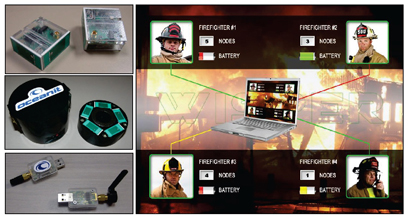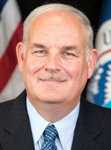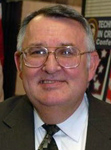A better mousetrap
Last month, nearly a decade after New York’s Twin Towers were struck by terrorist-flown airplanes, the U.S. Department of Homeland Security released a progress report based on security benchmarks set forth in the 9/11 Commission Report.
 Information-sharing and communications improvements were at the core of the report given to the Senate Committee on Homeland Security and Governmental Affairs by Greg Schaffer, acting deputy undersecretary of theDHS National Protection and Programs Directorate.
Information-sharing and communications improvements were at the core of the report given to the Senate Committee on Homeland Security and Governmental Affairs by Greg Schaffer, acting deputy undersecretary of theDHS National Protection and Programs Directorate.
Schaffer testified that the nation has come a long way since 9/11, starting with the creation of the DHS in November 2002. Now with more than 200,000 employees, DHS is the third largest Cabinet department, after the Departments of Defense and Veterans Affairs. One of its top priorities after 9/11 was to improve the communications capabilities of emergency responders. The first step in meeting this goal was creation of the National Incident Management System, or NIMS.
The second was establishment of the DHS Office of Emergency Communications.
Currently, the OEC is engaged in a nationwide assessment of emergency-communications capabilities. When complete, the assessment will provide a detailed view of capabilities at the county (or county-equivalent) level in all 56 states and territories, Schaffer said. In addition, the OEC recently completed the first goal identified in its National Emergency Communications Plan.
Specifically, the goal said that by this year 90% of all high-risk urban areas must be able to deploy response-level emergency communications within one hour for routine events involving multiple jurisdictions and agencies. Schaffer said that the OEC worked with the Urban Area Security Initiative (UASI) regions to assess each urban area’s capabilities during real-world events.
“The results have been encouraging — based on the capabilities documented at each event, all 60 urban areas were able to demonstrate the ability to establish response-level emergency communications in accordance with NECP Goal 1,” Schaffer said. “This illustrated how the significant organizational and technical investments made by the UASIs have improved their emergency-communications capabilities in recent years.”
The 9/11 Commission Report also called for the development of various communications technologies that would inform the public and help public-safety agencies during emergencies. Emphasis was placed on advancing firefighter-tracking technology.
While such technology, as well as firefighter-monitoring systems, has been in development for several years, the genre seems to be on the cusp of a quantum leap forward. Recently, the DHS Science & Technology (S&T) Directorate announced that a rugged firefighter tracking/monitoring technology has graduated from research and development and soon will be on the market. The multi-layered platform was unveiled last month at the Precision Indoor Personnel Location and Tracking International Technology Workshop at the Worcester (Mass.) Polytechnic Institute. It will enable fire chiefs to simultaneously monitor firefighters’ location, heart rates and body temperatures, said Jalal Mapar, S&T Directorate program manager.
The platform consists of three interconnected systems: GLANSER, PHASER and WISPER. When a firefighter reaches an incident, they are provided with a Geospatial Location Accountability and Navigation System for Emergency Responders, or GLANSER, which consists of a microwave radio, a lightweight battery and a suite of navigation devices embedded into a tracking device “the size of a paperback book,” Mapar said. GLANSER’s two-way signals are transmitted by a small, USB-powered base station that is housed in a laptop inside the fire truck. The sensors let commanders monitor firefighters’ locations remotely, he said.
 The Physiological Health Assessment System for Emergency Responders, or PHASER, is the second component of the system and monitors a firefighter’s body temperature, blood pressure and pulse. If a firefighter is in trouble, an alarm sounds on the laptop, and the firefighter’s location can be found via GLANSER.
The Physiological Health Assessment System for Emergency Responders, or PHASER, is the second component of the system and monitors a firefighter’s body temperature, blood pressure and pulse. If a firefighter is in trouble, an alarm sounds on the laptop, and the firefighter’s location can be found via GLANSER.
The final component is the Wireless Intelligent Sensor Platform for Emergency Responders, or WISPER — a 1-inch-square, ½-inch thick, throwaway router that’s waterproof and heat resistant up to 500°F. WISPER also contains a two-way digital radio, an antenna and a 3-volt lithium battery.
When firefighters enter a burning building, they are armed with five routers loaded in a belt-mounted waterproof canister, Mapar said. When they step beyond radio range, the base station outside the building orders the canister to drop a router. As routers are dropped, they automatically establish a link between each other to create a network. If a router accidentally gets disabled, the network will reconfigure, he said.
Honeywell will lead the team that will bring the product to market during the first quarter of 2012, Mapar said.
In 2008, the FCC issued a series of orders that identified the requirements for a Commercial Mobile Alert System (CMAS), via which commercial mobile service providers would transmit emergency alerts to their subscribers’ wireless handsets. The development of CMAS was mandated by the 2006 Warning, Alert and Response Network (WARN) Act, which also required wireless operators to declare whether they voluntarily issue such alerts.
Related story: Proposed alerting system sounds promising
Previously, the only other national emergency-alert system, or EAS, was developed in the 1950s for use by the president in the event of a nuclear attack. Today, it is available to the president for any alert that he believes is necessary. Oddly, though the EAS has been in place for more than half a century, it never has been tested end-to-end. That will occur in November, when local broadcasters’ systems will be monitored and evaluated to determine whether any issues exist.
Podcast: FEMA’s Penn on upcoming EAS nationwide test
But even if the EAS passes with flying colors, it has a key limitation: users have to be listening to the radio or watching TV to receive the alert, according to Denis Gusty, program manager for the S&T Directorate’s CMAS initiative.
“There’s a gap right then and there,” Gusty said. “They are not listening to the radio or TV constantly. That was the genesis of how CMAS came to be.”
Here’s how CMAS is supposed to work: emergency-alert origination teams will be located in local and state operation centers. Once it is determined that an alert is necessary, it will be written in 90 characters or less, sent to FEMA’s alert aggregator, and then transmitted to cellular providers for dissemination. Because each message will be geo-tagged, it only will be sent to the people who are in the vicinity of the impacted area.
CMAS is in the mid- to late-stage of development. The WARN Act requires that the system be operational by April 2012, Gusty said.
Meanwhile, the Department of Defense’s work on a software-defined, joint tactical radio system that would enable communications across disparate radio bands led to the development of the multiband radio. While multiband technology was conceptualized prior to 9/11, the terrorist attacks reinforced the need for a solution, said Tom Chirhart, S&T Directorate program manager.
Chirhart added that the technology would have been useful on 9/11 because the agencies responding operated on different radio bands. Indeed, much has been made of the lack of interoperable communications between the New York City police and fire departments on that day.
 “If there was a single radio band in use, if they had the ability to communicate from a command post environment to all of the responders that day, perhaps less lives would have been lost in this tragedy,” he said.
“If there was a single radio band in use, if they had the ability to communicate from a command post environment to all of the responders that day, perhaps less lives would have been lost in this tragedy,” he said.
Chirhart said that it was quite a feat to engineer a platform that would accommodate multiple bands, use a single antenna and fit within the form factor that public safety requires for its portable radios. If that wasn’t enough, any radio used by first responders also had to be intrinsically safe, built to an open standard and affordable.
“We need technologies to be built in open standards to ensure compatibility and affordability,” Chirhart said.
To date, Thales, Harris and Motorola have multiband radios on the market. Taking the time to get it right was essential, because mission-critical voice over LMR will be in play for a significant time to come, according to Chirhart.
Related commentary: Why aren’t more people talking about multiband radios?
“The added features offered by broadband and LTE are a great tool, but we are not going to see it soon,” he said. “Mission-critical voice will remain a critical aspect in the first-responder community.”
Related story: DHS’s Chirhart, Harris’s Martinez debate multiband radios
 The need for better information sharing also came to light as a result of the 9/11 terrorist attacks. Marc Caplan, the S&T Directorate’s chief of innovation technologies for the first-responder group, said that DHS sought ways to further enhance information sharing across local, regional, state, tribal and federal agencies. After looking at the development in October 2005 of the Alabama Department of Homeland Security’s Virtual Alabama, through which information-sharing technologies let emergency responders exchange data about cross-jurisdictional crimes, the agency developed its own version in 2009: Virtual USA.
The need for better information sharing also came to light as a result of the 9/11 terrorist attacks. Marc Caplan, the S&T Directorate’s chief of innovation technologies for the first-responder group, said that DHS sought ways to further enhance information sharing across local, regional, state, tribal and federal agencies. After looking at the development in October 2005 of the Alabama Department of Homeland Security’s Virtual Alabama, through which information-sharing technologies let emergency responders exchange data about cross-jurisdictional crimes, the agency developed its own version in 2009: Virtual USA.
The first phase of the project was devoted to educating first responders about the value of sharing information, the lack of which was a big problem in the aftermath of the attacks on the World Trade Center, according to Caplan.
For example, he said that police officers were coming down the stairwell as firefighters ascended the stairs. “It wasn’t good communications,” Caplan said. “One of the keys is building the relationship among the first-responder community, so they are willing to share information. Even with the technology there, if users don’t understand the value, they are not going to use it.”
For Virtual USA to work properly, the information that will be shared during an incident, its format, and with whom it will be shared, all must be identified well in advance of the emergency.
“When a critical incident occurs, that is no time to decide whether or not you want to share information and what kind of information might be out there to share,” Caplan said.
The S&T Directorate looked at existing information-sharing software systems to determine the best delivery of such data. The result was a Web portal that lets first responders share information across jurisdictions, geographical boundaries and operational organizations.
Currently, the program is focused on the state and local levels, but national data sharing is the next benchmark. Also, the S&T Directorate hopes to create a widget in the next year that will let first responders access Virtual USA from within their existing data systems.
“The first-responder community doesn’t want to go to another website, with another password, to figure out what’s going on during a critical incident and where the most appropriate data can be found,” Caplan said. “With the widget, they can pull that information into their native environment without a separate name and password.” Analytical tools also are being developed for the Web portal that will help agencies more effectively leverage the data in order to make better decisions, he said.
Podcast: Mock earthquake tests Virtual USA’s information-sharing
Virtual USA has been piloted in the Pacific Northwest and by the Central U.S. Earthquake Consortium, a Memphis, Tenn.-based entity, supported by FEMA, that provides planning, research and education services to the eight states in the region most at risk for an earthquake. It will be tested in the northeast this fall.
However, Virtual USA already has demonstrated its potential — in a big way. Only a few months after its launch, an explosion and fire on the Deepwater Horizon drilling rig licensed to British Petroleum resulted in 11 deaths, 17 injuries and the leakage of vast amounts of crude oil and natural gas into the Gulf of Mexico.
Response to the event involved myriad local, state and federal first-response units, BP and oil-industry experts, environmental agencies and others trying to resolve and assess the multifaceted damage created by the massive oil spill. Soon after the spill began, response groups asked whether the latest Virtual USA software could be made available, so that information about the spill could be shared quickly across jurisdictions and industry sectors.
Key information that successfully was shared through Virtual USA by the various response groups include updated weather reports, current flows in the Gulf of Mexico, location of cleanup crews, real-time mapping of the spill, field reports, and data regarding the impact of the oil spill on the health of local residents and wildlife and on the economy, particularly commercial fishing.
Podcast: Werner on Virtual USA
 David Boyd, director of the S&T Directorate’s command, control and interoperability division, called the experience “eye-opening.”
David Boyd, director of the S&T Directorate’s command, control and interoperability division, called the experience “eye-opening.”
“There’s nothing that’s a better test than the real thing, so it was a perfect opportunity for us to turn it on,” Boyd said at the time. “You always hate to put a positive twist on things that are so tragic, but this is an amazing opportunity to learn what’s possible.”
— Mary Rose Roberts










